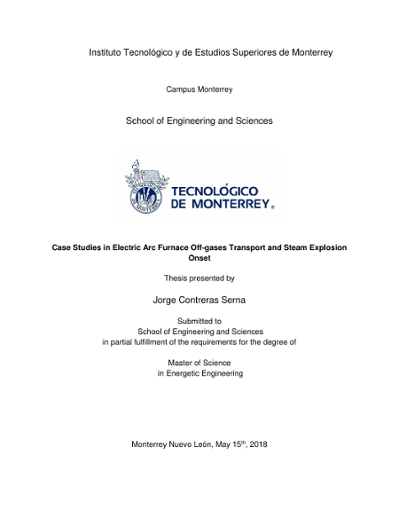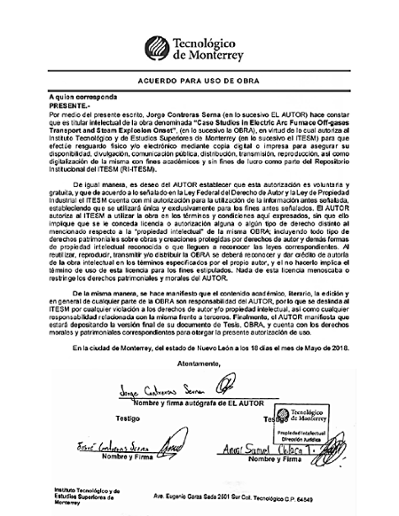| dc.contributor.advisor | García Cuéllar, Alejandro Javier | en_US |
| dc.contributor.author | Contreras Serna, Jorge | en_US |
| dc.date.accessioned | 2018-05-28T22:21:33Z | |
| dc.date.available | 2018-05-28T22:21:33Z | |
| dc.date.issued | 2018-05-15 | |
| dc.identifier.uri | http://hdl.handle.net/11285/629915 | |
| dc.description.abstract | Steel production in an EAF may pose a serious security risk in the event of water leaks into the molten steel, causing violent steam explosions. This thesis presents two important topics related to the Steel Making Industry. The first one is about the detection of water vapor (steam) inside the off-gas duct of an Electric Arc Furnace (EAF). And the Second one is about knowing the preconditions of melt fragmentation in a steam explosion. A way to detect the presence of large quantities of water inside the EAF is by monitoring its off-gas duct content of water vapor. Determining where to place a probe for water vapor detection inside the duct, is of the greatest importance as this might be the first warning for the appearance of a risk situation. A computational fluid dynamics (CFD) simulation is carried out using ANSYS Fluent software to obtain the point with highest concentration of water vapor. Water vapor channeling is assumed in the inlet of the off-gas duct so that a worst-case scenario is presented. Three-dimensional simulations were run with the inlet gas containing CO2, CO, H2O (steam), and air. The first three components enter through the duct while air enters through small gaps in the duct. Different combinations of the inlet position of CO2, CO and H2O were considered to estimate a pattern for the water vapor flow through the duct. The results show that if the steam enters in a channelized way, it will tend to continue in that path along the duct. The simulation results show the zones of the off-gas duct with a higher concentration of steam. These results can guide locating the gas probe and provide a better warning of a water leak. About the other topic, fragmentation of molten metal is an important process in steam explosions caused by melt-coolant interactions. This part of the research is dedicated to investigating how the fragmentation of the melt droplets occurs and melt jets formation in different mechanisms like a metal droplet falling in water or in a stratified water/liquid metal system. Also, an explanation of the most significant parameters in these processes is performed. 2-D computational fluid dynamics (CFD) simulations are carried out using ANSYS Fluent software to study these phenomena. The results show that the larger the pressure or density, the greater the melt jet length for a stratified system. And the larger velocity or density, the greater deformation for a melt droplet in a water pool. The formation of melt jets of Ciccarelli and Frost’s experiments is observed, and fragmentation of melt droplets was also observed during current simulations. | |
| dc.language.iso | eng | en_US |
| dc.publisher | Instituto Tecnológico y de Estudios Superiores de Monterrey | esp |
| dc.rights | Open Access | en_US |
| dc.rights.uri | http://creativecommons.org/licenses/by-nc/3.0/us/ | * |
| dc.title | Case studies in electric arc furnace Off-gases transport and steam explosion onset | en_US |
| dc.type | Tesis de Maestría | esp |
| thesis.degree.level | Maestro en Ciencias con especialidad en Ingeniería Energética | en_US |
| dc.contributor.committeemember | Rivera Solorio, Carlos Iván | en_US |
| dc.contributor.committeemember | López Salinas, José Luis | en_US |
| thesis.degree.discipline | Escuela de Ingeniería y Ciencias | en_US |
| thesis.degree.name | Maestría en Ciencias con especialidad en Ingeniería Energética | en_US |
| dc.subject.keyword | Steam Explosion | en_US |
| dc.subject.keyword | Computational Fluid Dynamics | en_US |
| dc.subject.keyword | Electric Arc Furnace Off-gas Duct | en_US |
| thesis.degree.program | Campus Monterrey | en_US |
| dc.subject.discipline | Ingeniería y Ciencias Aplicadas / Engineering & Applied Sciences | en_US |
| refterms.dateFOA | 2018-05-28T22:21:33Z | |
| html.description.abstract | <html>
<head>
<title></title>
</head>
<body>
<p>Steel production in an EAF may pose a serious security risk in the event of water leaks into the molten steel, causing violent steam explosions.</p>
<p>This thesis presents two important topics related to the Steel Making Industry. The first one is about the detection of water vapor (steam) inside the off-gas duct of an Electric Arc Furnace (EAF). And the Second one is about knowing the preconditions of melt fragmentation in a steam explosion.</p>
<p>A way to detect the presence of large quantities of water inside the EAF is by monitoring its off-gas duct content of water vapor. Determining where to place a probe for water vapor detection inside the duct, is of the greatest importance as this might be the first warning for the appearance of a risk situation. A computational fluid dynamics (CFD) simulation is carried out using ANSYS Fluent software to obtain the point with highest concentration of water vapor. Water vapor channeling is assumed in the inlet of the off-gas duct so that a worst-case scenario is presented.  Three-dimensional simulations were run with the inlet gas containing CO2, CO, H2O (steam), and air. The first three components enter through the duct while air enters through small gaps in the duct. Different combinations of the inlet position of CO2, CO and H2O were considered to estimate a pattern for the water vapor flow through the duct. The results show that if the steam enters in a channelized way, it will tend to continue in that path along the duct. The simulation results show the zones of the off-gas duct with a higher concentration of steam. These results can guide locating the gas probe and provide a better warning of a water leak.</p>
<p>About the other topic, fragmentation of molten metal is an important process in steam explosions caused by melt-coolant interactions. This part of the research is dedicated to investigating how the fragmentation of the melt droplets occurs and melt jets formation in different mechanisms like a metal droplet falling in water or in a stratified water/liquid metal system. Also, an explanation of the most significant parameters in these processes is performed. 2-D computational fluid dynamics (CFD) simulations are carried out using ANSYS Fluent software to study these phenomena.  The results show that the larger the pressure or density, the greater the melt jet length for a stratified system. And the larger velocity or density, the greater deformation for a melt droplet in a water pool. The formation of melt jets of Ciccarelli and Frost’s experiments is observed, and fragmentation of melt droplets was also observed during current simulations.</p>
</body>
</html> | en_US |


